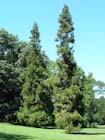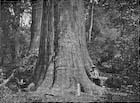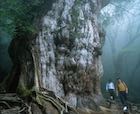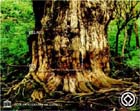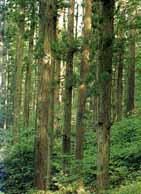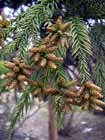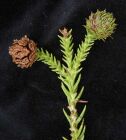Cryptomeria japonica
(Thunberg ex Linnaeus f.) D. Don 1839
Common names
スギ sugi [Japanese]; 柳杉 liu shan [Chinese]; sugi, Cryptomeria, Japanese cedar. In the USA it is most often called Cryptomeria.
Taxonomic notes
The genus is Cryptomeria D. Don, Ann. Nat. Hist. 1: 233. 1838. There is one species with two varieties, distinguished by range and by morphological differences detailed below.
- Cryptomeria japonica var. japonica. Syn: Cupressus japonica Thunberg ex Linnaeus f., Suppl. Pl. 421. 1782; Taxodium japonicum (Thunberg ex Linnaeus f.) Brongniart (Fu et al. 1999).
- Cryptomeria japonica var. sinensis Miquel in Siebold & Zuccarini, Fl. Jap. 2: 52. 1870. Syn: Cryptomeria kawaii Hayata; C. mairei (H. Léveillé) Nakai; Cupressus mairei H. Léveillé; Cryptomeria fortunei Hooibrenk (nom. inval.) (Fu et al. 1999).
Description
Trees monoecious, evergreen, up to 50(-65) m tall and up to 300 cm in diameter, with a conical crown and a straight, slender trunk. Bark reddish brown to dark gray, fibrous, peeling off in strips. Branches ± whorled, horizontally spreading or slightly pendulous; branchlets usually pendulous, those of 1st year green. Shoots green, glabrous. Winter buds small, not scaly. Leaves persisting 4 or 5 years, needle-like, pale green, spirally arranged in 5 ranks, spreading or directed forward, subulate to linear, ± straight or strongly incurved, adaxial and abaxial surfaces convex, rigid, lateral surfaces slightly flattened, keeled, stomatal bands with 2-8 rows of stomata present on all 4 surfaces, base decurrent, apex acute. Leaves on leader branchlets borne at 15-45° to axis, those on short (fertile) branchlets at 30-55° to axis, length (0.4-)0.7-1.4(-2) cm × 0.8-1.2 mm wide (width measured near base of two wider surfaces). Pollen cones axillary toward apex of second-year branchlets, usually crowded into a terminal, sessile, oblong raceme of 6-35, ovoid or ovoid-ellipsoid, (2-)2.5-5(-8) × (1.3-)2-3(-4) mm, each cone (except basal and apical) subtended by a leaf shorter than to 1.5 × length of cone. Pollen cones are plum red turning yellow when mature; microsporophylls many, spirally arranged; pollen sacs (3 or)4 or 5(or 6). Seed cones are borne from the fifth year onward. They are borne in groups of 1-6, terminal, solitary or occasionally aggregated, nodding, sessile, globose or subglobose, rosettelike and resembling opening buds, 0.9-1.6(-2.5) × 1-2(-2.5) cm; cone scales 20-30, proximal 2 margins often convex in outline, or all 4 margins ± concave in outline, middle part with or without distinct shoulders at widest point, apex usually recurved, umbo rhombic, distally with 4 or 5(-7) toothlike projections 1-3.5 mm. Cones ripen (color brown) in the first year and persist 1-2 years longer, with branchlet growth often temporarily continuing through cone. Seeds brown or dark brown, 2-5 on each scale, irregularly ellipsoid or multiangular and ± compressed, 4-6.5 × 2-3.5 mm; wings 0.2-0.25 mm wide. Cotyledons (2-)3(-4), linear and up to 2 cm in length. Germination epigeal. Pollination Feb-Apr, seed maturity Oct. 2n = 22* (Vidakovic 1991, Fu et al. 1999).
Key to the varieties (Fu et al. 1999):
1a. |
Leaves ± straight at least in proximal 1/2, often recurved apically on leader branchlets, arising at 35-45° to axis on leader branchlets, 45-55° on fertile branchlets, rigid and hard; most pollen cones longer than their subtending leaf; cone scales 20-30, each bearing 2-5 seeds; distal projections of bracts and cone scales 2-3.5 mm. |
1a. var. japonica |
1b. |
Leaves usually strongly incurved throughout, arising at 15-30° to axis on leader branchlets, 30-40° on fertile branchlets, rigid but relatively soft; most pollen cones shorter than their subtending leaf; cone scales ca. 20, each bearing 2 seeds; distal projections of bracts and cone scales 1-2 mm. |
1b. var. sinensis |
Distribution and Ecology
China and Japan. Var. japonica is native only to Japan, where it occurs naturally in pure and mixed stands from Kyushu to N Honshu at elevations to 400 m (Vidakovic 1991). The variety is also widely introduced for forestry in Taiwan and many provinces of mainland China. Var. sinensis is native to China: Fujian (Nanping Shi), Jiangxi (Lu Shan), Sichuan, Yunnan, and NW Zhejiang (Tianmu Shan), and is also widely introduced for forestry in other provinces of China. It grows in forests on deep, well-drained soils subject to warm, moist conditions at elevations from below 1100 m to 2500 m (Fu et al. 1999). Var. japonica is hardy to Zone 6 (cold hardiness limit between -23.2°C and -17.8°C) (Bannister and Neuner 2001).
Remarkable Specimens
The top contenders for the largest specimen are Yaku-sugi, the giant trees that have been preserved on Yakushima Island. Jomon-sugi is a particularly well known Yaku-sugi, 5.2 meters in diameter and 25.3 meters tall; another Yaku-sugi is 34.9 m tall (Anonymous-1a). I suspect the photograph at right is of the Jomon-sugi. Matsuzawa (1998) provides further details, as does UNEP-WCMC (1993), and useful information for anyone wanting to visit these trees is provided by JNTO (2006). A map of the island, showing the locations of notable Yaku-sugi is provided by Anonymous-1b.
The tallest specimen is probably in cultivation; the tallest recorded ones are ornamentals. A summary of these trees is provided by Monumental Trees (2018) and includes specimens larger than 100 cm DBH and 30 m tall in many European countries (also the USA).
There are few data on very old trees. Certain trees are popularly thought to be over 1,000 years old and the "Jomon" is a time about 3,000 years ago. Some websites repeat an old and fanciful claim that the Jomon-sugi is 7200 years old, but there is no basis for this assertion; it is simply folklore. Ota (1985, cited by Suzuki and Tsukahara 1987) published a radiocarbon date of 3000±160 years for the Jomon sugi. There is no good reason why the species cannot attain such an age, but I have not seen Ota's paper (which is in Japanese, so just seeing it wouldn't help me much), and I know that there are several reasons why such a date might be an overestimate. For instance, the sample could have incorporated old carbon derived from soil sources, to say nothing of the lab errors that were widespread in the early days of radiocarbon dating. Thus, for the time being, I remain sceptical of Ota's published age for the Jomon sugi.
Suzuki and Tsukahara (1987) state that "a section of trunk of C. japonica cut at 6 m above the ground had 1776 annual rings, and is stored in Shimoyaku Forestry Office." This seems like a very credible age. Suzuki (1997) publishes well-supported dates of 1400 years and 1345 years for two trees from Yakushima island. These ages are based on ring counts from stumps cut at a known time in the 18th and 19th Centuries. Suzuki relates that, due to widespread logging at that time, the older residual sugis are easily distinguished from the younger cohort. The older trees, popularly supposed to be over 1000 years old, are called yakusugi and are present on the landscape at a density of about one tree per hectare. Based on Suzuki's data, it's probably more accurate to say that the yakusugi are over 700 years old. The younger trees are called kosugi or "child sugi" and are of course much more abundant. Suzuki also found extremely old Chamaecyparis obtusa, Tsuga sieboldii and Abies firma growing in the Yakushima forests.
Ethnobotany
Wilson (1916) states that "the Cryptomeria is the most generally useful and popular tree in Japan and has been planted there from time immemorial." The wood is strongly rot resistant, easily worked, and is used for buildings, bridges, ships, lamp posts, furniture, utensils, and paper manufacture (Fu et al. 1999). In Japan, sugi and HINOKI (Chamaecyparis obtusa) are the most economically important timber species. Sugi has long been valued for the beauty of both the tree and wood and is widely planted around temples. Outside of China and Japan, it is very widely cultivated as an ornamental in warm and cool temperate climates.
Research uses include dendrochronology; a review study was published by Kojo (1987).
Observations
Personally, I would head straight to Yakushima ("Big Tree," above). Vidakovic (1991) says that "One of the most impressive forests in the world is the 250-year old stand of C. japonica at Nikko, where trees attain 65 m in height and up to 2 m in diameter." Nikko is also home to the Cedar Avenue, a 35 km long avenue planted with Cryptomeria 400 years ago; it is both a natural and a cultural national monument. Natural stands can be seen at the Todo and Sado Cedar Virgin Forests, near Moriyoshi and Ani towns, Kita-akita county, Akita prefecture (FAS 1998). Taiwan's Shei-Pa National Park also looks like an interesting place to see it.
Wilson (1916), though obviously dated, offers a thorough and intriguing account of what he considers the best sites to see this species: "The Cryptomeria, or Sugi as it as called in Japan, is the noblest of the Japanese conifers and many famous places in Japan owe much of their charm to stately avenues and groves of this impressive tree. There is a solemnity and a dignity about it, with its perfectly straight trunk towering heavenward and topped with a conical dark green crown, as befits a tree used for enshrouding temples, shrines and sacred places generally. The famous and well-known avenues at Nikko, said to be the humble gift of a Daimyo poor in worldly goods, is the most magnificent of all the monuments raised to the memory of the first Shogun. Although much less well known, there are in different parts of Japan many avenues and groves of Cryptomeria with larger trees than those at Nikko. At the shrines of Ise there are said to be some wonderful old trees, but I did not visit this famous place. The finest tree I saw, and probably the largest in all Japan, is in the grounds of a temple at Sugi, a village in Tosa province, Shikoku, which measures 50 m. in height and 25 m. in girth. It is in perfect health, though the top has been broken off by storms and formerly its height was fully 15 m. more than it is now. At the shrine of Jimmu-Tenno, the first Emperor, at Sano in Osumi province, Kyushu, there is a fine avenue of Cryptomeria planted some 500 years ago, the trees being from 50 to 60 m. tall and from 3 to 6 m. in girth. On the Kasuga-yama at Nara there are trees from 40 to 50 m. tall and from 10 to 12 m. in girth of trunk. In the park and temple grounds, too, at Nara are many magnificent old Cryptomerias. The most impressive avenue I saw is that on Koya-san on the borders of Yamato and Kii provinces, which I was told was planted by one Ogo Shonin, a priest, about 650 years ago. This avenue is more than a mile long and the trees range from 40 to 60 m. in height and from 4 to 8 m. in girth of trunk, and I believe with Elwes that they "surpass in grandeur any other trees planted by man in the world." I have mentioned the curious association of Trochodendron and Cryptomeria, and in these avenues and groves it is a not uncommon thing to see other conifers or even broad-leaved trees growing on living and apparently perfectly sound trees of Cryptomeria. At the entrance to the Futaara Temple at Nikko a tree of Quercus glandulifera Bl. a metre in girth may be seen growing from the side of a perfectly healthy Cryptomeria, at about 4 m. from the ground, as if it were a natural branch of the tree. Whatever cavity there was when the acorn was deposited is entirely filled, and above and below the Oak nothing, not even a swelling, is visible. The heart of these trees is often decayed, and I suppose the roots of the Oak have found their way there and then to the ground. That the Cryptomeria can play the part of guest as well as that of host is exemplified at Nara, where at Kasuga shrine a tree of Cryptomeria 25 m. tall and more than 1 m. in girth is growing from the side of a Juniperus chinensis L., which is 18 m. tall and 5 m. in girth. In the groves and avenues the Cryptomeria trees were planted very close together, with the result that in time at their base numerous trunks have become fused into one butt of irregular shape, giving the impression of numerous trunks rising from a common stool. The impression is entirely false as the Cryptomeria does not sucker nor stool, nor are adventitious growths developed by it. The Nikko avenue shows this phenomenon remarkably well. Another point of interest is that the planted trees of the Sugi exceed in average height the wild trees in the forests."
I have seen var. sinensis growing wild in Sichuan near Datung, on the Min River.
Remarks
Name is derived from the Greek kryptos, hidden, and meros, part (Vidakovic 1991). The meaning of this is unknown to me.
The opening scene of Samurai I: Musashi Miyamoto (1954) features two young men watching the action from high in the branches of a huge Cryptomeria.
Citations
Anonymous-1a. [no date]. Hananoego Moor, Yamato-sugi Cedar. http://www.asahi-net.or.jp/~hn7y-mur/mononoke/monolink10link2e.htm, accessed 2009.04.03.
Anonymous-1b. [no date]. Scenery of the Yakushima island. http://www.asahi-net.or.jp/~hn7y-mur/mononoke/monolink10e.htm, accessed 2009.04.03.
Anonymous-2. [no date]. Palau. https://www.wood.co.jp/stamps/palau.htm, accessed 2009.04.03, now defunct.
D. Don, Ann. Nat. Hist. 1: 233. 1838.
FAS. 1998. Todo and Sado Cedar Virgin Forest. http://www.media-akita.or.jp/akita-monuments/sugiE.html, accessed 2006.11.01, now defunct.
Forestry and Forest Products Research Institute (FFPRI). 1996. Introduction to Forestry and Forest Products Research Institute. http://ss.ffpri.affrc.go.jp/outline.html, accessed 1998.10.12, now defunct.
JNTO [Japan National Tourism Organization]. 2006. Website | Japan In-Depth | Featured Articles | World Heritage Sites in Japan | Yakushima. http://www.jnto.go.jp/eng/indepth/featuredarticles/worldheritage/c_12_yakushima.html, accessed 2009.04.03, now defunct.
Kojo Y. 1987. A dendrochronological study of Cryptomeria japonica in Japan. Tree-Ring Bulletin 47:1-21.
Matsuzawa Kazumi. 1998. Yaku-island: The Richest Natural Environment in Japan. https://webdisk.lclark.edu/krauss/cwis/computersp98/culturecapsules/alhajeriweb/alhajeri.html, accessed 2019.03.01, now defunct.
Monumental Trees. 2018. The thickest, tallest, and oldest sugi trees (Cryptomeria japonica). https://www.monumentaltrees.com/en/trees/cryptomeriajaponica/records/, accessed 2018.11.24.
Ota S. 1985. Riddles of Joumon sugi (the biggest Cryptomeria japonica) - its ecology and age. Plant and Nature 19(3):19-22 [in Japanese].
Suzuki Eizi. 1997. The dynamics of old Cryptomeria japonica forest on Yakushima Island. Tropics 6(4):421-428.
Suzuki E. and Tsukahara J. 1987. Age structure and regeneration of old growth Cryptomeria japonica forests on Yakushima Island. Bot. Mag. Tokyo 100:223-241.
UNEP-WCMC [United Nations Environment Programme-World Conservation Monitoring Centre]. 1993. UNEP-WCMC Protected Areas Programme - Yakushima. http://www.unep-wcmc.org/sites/wh/yaku.html, accessed 2006.11.01, now defunct.
See also
Cheng, W. C. and L. K. Fu, eds. 1987. Flora Reipublicae Popularis Sinicae. Tomus 7: Gymnospermae. Beijing: Kexue Chubanshe.
Elwes and Henry 1906-1913 at the Biodiversity Heritage Library (Photos). This series of volumes, privately printed, provides some of the most engaging descriptions of conifers ever published. Although they only treat species cultivated in the U.K. and Ireland, and the taxonomy is a bit dated, still these accounts are thorough, treating such topics as species description, range, varieties, exceptionally old or tall specimens, remarkable trees, and cultivation. Despite being over a century old, they are generally accurate, and are illustrated with some remarkable photographs and lithographs.
Farjon 2005.

